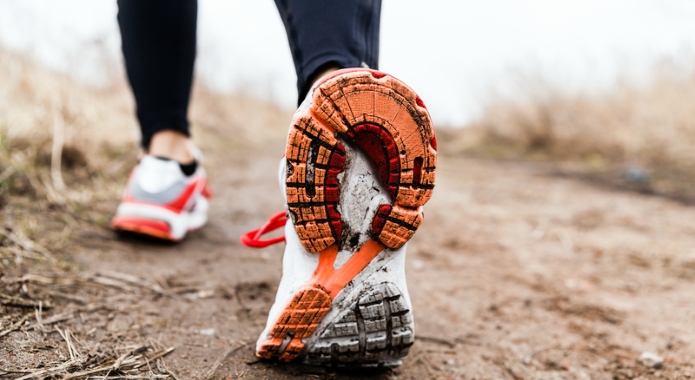

It has become trendy today for every physical fitness guru to recommend walking 5 miles a day, to keep fit and stay healthy. Well, over 2000 years ago, Hippocrates, the father of modern medicine is quoted saying that:
“Walking is a man’s best medicine.”
Former director of the U.S. Centers for Disease Control and Prevention, Dr. Thomas Frieden couldn’t agree more. He reiterates by saying that walking is “the closest thing we have to a wonder drug.” The Centers for Disease Control and Prevention (CDC) recommends that adults should have 150 minutes of moderate activity in a week, to stay healthy.
For walking, that would translate to a brisk walk of 8000 steps daily or 4 miles a day. Well, what about the 5 miles a day or 10000 steps goal that every pedometer on the market is set to achieve?
ORIGINS OF 5 MILES (10,000 STEPS) A DAY GOAL
The 10,000 steps goal, has its origin in the 60s in Japan where a Japanese pedometer manufacturer started selling his with’ manpo-kei,’ pedometers, the terminology translating to “10,000-step meter” in English.
Various studies confirming the health benefits of taking 10,000 steps a day, popularized the number further and the fact that the number is enormous and well rounded doesn’t hurt either.
The best part? This goal can fit easily into anyone’s schedule and has no age limitations. The average human has a 2.5 feet long stride, which translates to 2,000 steps a mile. 10,000 steps would bag you 5 miles a day.
HELPS LOSE WEIGHT IN A HEALTHY WAY
(BENEFIT #1)

The speed of your walk is a significant factor you must incorporate into your walking program. A Cooper Institute for Aerobics Research study published in Journal of the American Medical Association shows that between women who walked at either three, four or five mile an hour, the ones who benefit most from walks, are the fastest.
An International Journal of Sports Medicine study, also shows that race walkers achieve as many cardiovascular benefits as runners. If your goal is to burn fat, you should ensure that you are walking briskly enough to get to 55 to 65 of your maximum heart rate, which is referred to as the ‘ fat-burning zone.’
You can determine your maximum heart rate by subtracting your age from 220.
Do you still need help to figure it out? Usually, a speed of 2 to 3 mph is intense enough to place you into the fat burning zone. A brisk walk slightly elevates your heart rate and gets you warm when walking. When having a brisk walk you should be able to converse but not sing.
To burn maximum calories from fats and carbs, you need to walk fast enough to get to 75% of your maximum heart rate. This should be about 3 to 4 miles per hour. At this speed, you will find yourself gasping for a breathe every sentence or two during a conversation.
A light jog is done at rates of 4 to 5 miles per hour.
To boost calorie burning, you should alternate between brisk walking and short bouts of vigorous high-intensity walks. This can, in turn, assist your body burn 3,500 calories, which are the equivalent of one pound of weight. It may sound like too many calories, but remember this is done over time. You just need to keep chipping away at the calories, and the results of your walk should manifest with time.
The key is finding the optimum calorie burning speeds for your weight loss goals.
A 200-pound person burns approximately 396 calories an hour when walking at three mph. If they walked at 4mph, they would burn around 468 calories instead. Cumulatively this amounts to a pound (or 3,500 calories) off of you in nine walking hours and two pounds per month, if you walk five times a week. How cool is that?
The beauty of it is that these number of steps can be fit in throughout your day and with your Fitbit or pedometer on, this has never been easier to monitor. To calculate how much calories you burn while walking, check out this calculator here.
CALORIES BURNED PER WALKING 5 MILES
WEIGHT | SLOW SPEED | NORMAL SPEED | FAST SPEED |
|---|---|---|---|
100 lbs | 286 calories | 278 calories | 290 calories |
120 lbs | 343 calories | 333 calories | 348 calories |
140 lbs | 400 calories | 389 calories | 406 calories |
160 lbs | 457 calories | 445 calories | 464 calories |
180 lbs | 514 calories | 500 calories | 522 calories |
200 lbs | 572 calories | 556 calories | 580 calories |
220 lbs | 629 calories | 611 calories | 638 calories |
240 lbs | 686 calories | 667 calories | 696 calories |
260 lbs | 743 calories | 722 calories | 754 calories |
280 lbs | 800 calories | 778 calories | 812 calories |
300 lbs | 857 calories | 833 calories | 870 calories |
RELATED RESEARCH STUDY:
“In this study, previously sedentary, overweight or obese postmenopausal women experienced a graded dose-response change in fitness across levels of exercise training.”
– Church, T. S., et al. (2007). “Effects of Different Doses of Physical Activity on Cardiorespiratory Fitness Among Sedentary, Overweight or Obese Postmenopausal Women With Elevated Blood Pressure”, in The JAMA Network. Vol. 297(19). Pp. 2081-2091
COUNTERACTS WEIGHT-PROMOTING GENES
(BENEFIT #2)

The world of puff pastry lovers has two groups, those who enjoy every bit of the crust and forget about it, and those whose bodies send it straight to their thighs. While environmental factors largely affect obesity, researchers at the University of California L.A. in a study funded by the National Institute of Health have identified that your genetic disposition affects your ability to burn calories.
And while this should spell doom for many muffin lovers around the world, hope has come from the most unlikely of places.
Walking!
Harvard researchers poring and mulling over 32 obesity-promoting genes and their ability to drive you up the wall have discovered that a brisk walk can efficiently cut the effects of these genes on your body by half.
In fact, the impact of an hour of a quick walk daily should do it. A University of Utah study chimes in with the discovery that every single moment spent walking briskly during the day could lower the risk of obesity by 5%.
RELATED RESEARCH STUDY:
“Exercise training, regardless of weight loss, provides numerous health benefits especially for overweight and obese individuals at risk for CV diseases or with current CV conditions.”
– Swift, D. L., et al. (2014). “The Role of Exercise and Physical Activity in Weight Loss and Maintenance”, in Progress in Cardiovascular Diseases. Vol. 56(4). Pp. 441-447
HELPS FIGHT OFF CANCER
(BENEFIT #3)

As each year passes, the statistics on cancer grow grimmer and grimmer, and for example, based on this 2010-2012 data, about 40% of men and women will be at some point diagnosed with some form cancer in their lifetime. According to these statistics, besides lung cancer, breast cancer causes more deaths than any other cancer in the U.S.
There is good news though from the American Cancer Society, which has done a study that shows, that women who walk for at least seven hours a week have a 14% lower risk of breast cancer, than those who do so for three hours or less in a week.
Walking at a jogging pace of 5mph, you could cover one mile in 12 minutes, and utilize one hour for all 10,000 steps!
Well, there is more.
Research presented at an American Society for Clinical Oncology (ASCO) conference, shows that women with breast cancer who manage to walk briskly for 180 minutes a week, had 50% more chance of surviving the disease over an eight-year period than those who didn’t.
Researcher Sandra Haye of the Queensland University of Technology, who did the study, says that besides surviving the cancers, keeping active through walks, helps patients improve their quality of life, well being and health during the rigors of treatment and after. The same optimism is shared for patients with bowel cancer regarding the ability of a moderate intensity 150 minutes brisk walk to reduce the risk of mortality by 42%.
University of California San Francisco professor Erin van Blarigan, the lead researcher of this study, says that the exercise could reduce death from bowel cancer by lowering the insulin levels in the blood and therefore reducing insulin resistance, which are prerequisites for cancers and heart disease.
RELATED RESEARCH STUDY:
“Overall cancer mortality rates have decreased in the U.S. 58 and there are over 10.5 million cancer survivors59. Evidence suggests that exercise can contribute to the well-being (physical functioning, fatigue, QOL) of these survivors.”
– Pinto, B. M., & Floyd, A. (2007). “Methodological Issues in Exercise Intervention Research in Oncology”, in Seminars in Oncology Nursing. Vol. 23(4). Pp. 297-304
HELPS KEEP JOINT PAINS AWAY
(BENEFIT #4)

Walking can be of benefit to your joints, increasing their lubrication as well as increasing the delivery of nutrients. This assists in the reduction of pain brought on by arthritis. Studies show that walking especially protects the hips and knees, which are most susceptible to osteoarthritis.
Not only that, it strengthens your muscles while helps lubricate your joints as well. Did you know that walking five to six miles a week can even prevent arthritis from forming in the first place? Isn’t that awesome?
According to Arthritis.org, the study of post-menopausal women in Boston found that 30 minutes of walking each day reduced their risk of hip fractures by 40 percent.
RELATED RESEARCH STUDY:
“Both aerobic walking and home based quadriceps strengthening exercise reduce pain and disability from knee osteoarthritis but no difference between them was found on indirect comparison.“
– Roddy, E., et al. (2005). “Aerobic walking or strengthening exercise for osteoarthritis of the knee? A systematic review”, in Annals of the Rheumatic Diseases. Vol. 64(4). Pp. 544-548
BOOSTS YOUR IMMUNE SYSTEM
(BENEFIT #5)

We all know how debilitating man-flu can be, and studies suggest there is more to man flu than meets the eye. No, it’s not a sign of a wimpy man either, but it could be that flu is more severe in men than women!
Well besides vaccinations and proper hand washing and extreme measures such as donning gas masks you can protect yourself by taking a brisk 20 minutes walk, at least five days a week. Studies done amongst 1000 men and women show that those who made the prescribed walk had 43% less sick days during flu season!
This Appalachian State University in North Carolina study shows that a daily half an hour brisk walk can remarkably increase the number of immune cells in your body.
RELATED RESEARCH STUDY:
“Perceived physical fitness and frequency of aerobic exercise are important correlates of reduced days with URTI and severity of symptoms during the winter and fall common cold seasons.”
– Nieman, D. C., et al. (2011). “Upper respiratory tract infection is reduced in physically fit and active adults”, in British Journal of Sports Medicine. Vol. 45(12). Pp. 987-992
HELPS CONTROL YOUR SWEET TOOTH
(BENEFIT #6)

If you are prone to comfort eating, and you are bent especially on chocolate and are bulging around the waist, then there is hope for you. University of Exeter’s Sport and Health Sciences Professor, Adrian Taylor and his team have studied the phenomenon at length and concluded that exercise or a brisk walk, can potentially manage addictions, especially of the high-calorie food kind.
Walking your 10,000 steps a day will release endorphins into your system and reverse the cortisol levels, that prompt the binge eating in the first place. This approach gives better outcomes for patients with type 2 Diabetes.
RELATED RESEARCH STUDY:
“The endorphin hypothesis predicts that exercise has a positive effect on depression due to an increased release of β-endorphins following exercise. Endorphins are related to a positive mood and an overall enhanced sense of well-being. This line of research has not been without criticism. The debate remains as to whether plasma endorphins reflect endorphin activity in the brain.”
– Craft, L. L., & Perna, F. M. (2004). “The Benefits of Exercise for the Clinically Depressed”, in The Primary Care Companion to the Journal of Clinical Psychiatry. Vol. 6(3). Pp. 104-111
AIDS BRAIN ACTIVITY
(BENEFIT #7)

Studies show that walking induces pressure waves that travel through up your arteries, increasing blood flow to your brain. This phenomenon lends itself to running too, but researcher Ernest R. Greene of New Mexico Highlands University says that walking does a better job at it, because it is in harmony with the heart.
This phenomenon is remarkable because this increase in blood flow means more glucose and oxygen to your grey matter which positively impacts memory, mental acuity, mood, and overall brain function, lessening the chances of dementia, and improving both your mood and creativity.
RELATED RESEARCH STUDY:
“There is a continuum of hemodynamic effects on human brain blood flow within pedaling, walking and running. Speculatively, these activities may optimize brain perfusion, function, and overall sense of wellbeing during exercise. What is surprising is that it took so long for us to finally measure these obvious hydraulic effects on cerebral blood flow.”
– Greene, E.R. (2017). “Acute Effects of Walking on Human Internal Carotid Blood Flow“.
REDUCES RISK OF PREMATURE DEATH
(BENEFIT #8)

A University of Cambridge study on 334,000 people has proven that walking can keep the grim reaper away. The study concluded that a daily 20 minutes brisk walk, cuts the risk of premature deaths by 15%. Walking is deemed especially perfect for the reduction of the risk of mortality due to respiratory and cardiovascular reasons.
If you can start your 10,000 steps a day from an early age, the exercise should additionally assist you to stay independent and mobile during your sunset years.
RELATED RESEARCH STUDY:
“Engaging in any walking or other MVPA, even if not meeting the minimum recommended levels, is associated with lower mortality compared with inactivity. Meeting minimum MVPA recommendations through walking only is associated with a further increase in longevity in older adults. Although physical activity has been associated with numerous health benefits for older adults, including longevity, better mental health, improved cognitive functioning, and lower risk of various chronic diseases, less than half of older adults meet physical activity recommendations.”
– Patel, A. V., et al. (2018). “Walking in Relation to Mortality in a Large Prospective Cohort of Older U.S. Adults”, in American Journal of Preventive Medicine. Vol. 54(1). Pp. 10-19
KEEPS THE HEART HEALTHY
(BENEFIT #9)

Walking for 2.5 hours each week can reduce the risk of heart disease by 30% according to a study done by the Harvard Medical School. The reason is simple, walking gets your blood pumping, without straining your cardiovascular system.
This in effect reduces chances of cardiovascular events such as heart failure, heart attack, angioplasty, stroke or angina.
The Stroke Association U. K. recommends a 30-minute daily stroll to ensure that your blood pressure is kept in check. This study suggests that clinicians should prescribe walking to cardiovascular disease patients.
RELATED RESEARCH STUDY:
“Evidence from epidemiological studies suggest that even small improvements in the amount of daily walking is better than no walking, and greater increases confer larger cardiovascular health benefits. Patients may accrue short-terms gains such as improved fitness, body composition, blood pressure and lipid profiles. Longer term benefits include reduced risk of CHD, coronary events and mortality. Patients should gradually raise their walking levels, with the public health recommendation of 150 minutes per week as a minimum goal.“
– Murtagh, E. M., et al. (2010). “Walking – the first steps in cardiovascular disease prevention”, in Current Opinion in Cardiology. Vol. 25(5). Pp. 490-496







